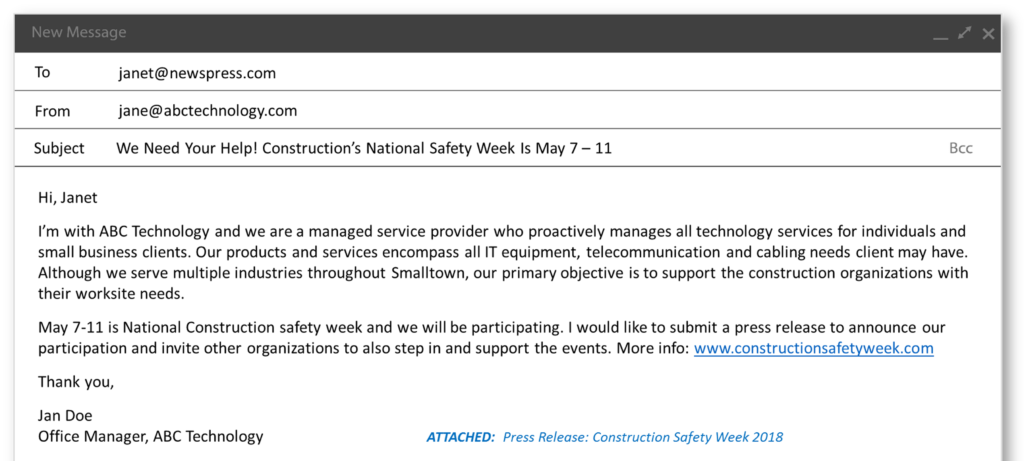Over the past few weeks, we’ve been exploring the use of press releases in your overall marketing strategy for selling managed services. We’ve started from the very beginning to better understand what a press release actually is and gone through the steps of developing a release for publication.
In this article, we will go over the necessities of actually submitting your press release for publication.
8 TIPS TO SUBMITTING YOUR PRESS RELEASE
- INTRODUCE YOURSELF EARLY
If you want these people to jump when you say so, you better have a relationship with them already established. I can’t imagine how many people pop up out of know where because they have something they want published. Regardless how interesting your press release is, no one has to care. People work with people they like. You must build relationships!
Connecting with them on LinkedIn is always a great place to start. Also, most people that work within the media industry do their best to be reachable. Many journalists feature their email directly within their content. If that’s not the case, check out their Twitter bios. Whether you follow each other or not, mention them in a tweet and I would bet 80% of them would respond back in some form or another. After all, they’re in the business of knowing people!
But what if you can’t find their contact information, despite all your efforts and they seem particularly aligned with your goals… you can always rely on favorite resource: LinkedIn with Dux Soup (Chrome Extension)
— > But wait, let me offer one significant piece of advice as you’re now documenting your media list: Think about quality, not just quantity. A big fat list of the wrong people has no value however, a shorter list of tightly targeted movers and shakers would likely provide immense, long term value.
2. WRITE SIMPLE & DIRECT EMAILS
You don’t want to distract the reader from the plain and simple point you’re trying to make. Don’t go into a lot of detail within the body of your message because you will attach your press release to the correspondence. Say who you are, why you’re reaching out and note that there is an attachment you’d like them to review.
Following up is on you. Here’s an example:
3. FIND THE BEST TIME TO REACH OUT
69% of journalists prefer to be contacted in the morning, according to BuzzStream research. We’ve done our research too and found the following to be true:
When someone gets back to you, it’s ok to ask for their preferences so you can refine the data in your CRM and stop guessing.
4. PRACTICE BEFORE GAME DAY!
Don’t let your most important outreach campaign be the first one. Prepare in advance and be ready to fail a few times before you understand what works for you.
5. MAKE SURE YOU’RE AVAILABLE
When you finally get some traction, try to be available whenever a journalist needs you. If you stick to a 9-to-5 office routine you may miss the opportunity to help a reporter out when the deadline is close. Also, it doesn’t look too good to pester someone during office hours and never check your email on evenings and weekends.
6. BE TRANSPARENT AND COMMUNICATE
Once you exchange a few emails with someone, it’s ok to ask for their preferences. Is it true they prefer to be pitched in the morning? Is email the best way? How should you link to additional resources like press kit, press release, etc? Any personal preference can be added to your list for further reference and can give you insights about journalists and influencers in your industry.
7. BE RESPECTFUL
Be sure to think before you react. Often times, journalists and such are living on their next deadline. They may seem rushed or unengaged once you actually do get them on the phone or in email. Don’t rush to judgment that it’s them being rude to you.
Also, as we’ve already talked about… you’re not going to get your way all the time. No pouting or poor attitudes is the results aren’t the same as your high hopes.
8. KEEP REFINING THE LIST
Your list is not something you do once and use forever but rather an ongoing project you need to refresh often. Use networking moments to enlarge your list, take some time to read and comment the latest articles by your favorite bloggers and journalists that you now follow (right!?).
If you do this on a weekly basis, you’ll also notice when someone gets a new job, or a new magazine launches, or there are news about the editorial staff of your favorite magazine. Every change goes directly to your amazing list of media contacts. Also, double check it’s accuracy before using. People shift around often and you don’t want your very important press release to go into someone’s dead inbox.
IN CONCLUSION
So, we’ve made it through Press Release 101. As far as I see it, there’s just two important things you need to keep your eye on:
- Maintaining an expert level of awareness and knowledge within your industry and verticals along with future IT issues the rest of us don’t see coming. Pay attention to your community, read relevant publications, get specific with your interests…
- Building and managing your media list. While I’ve created a super simple but super effective template for you to use, you’ll have to take it across the finish line.
Trust me. You can do this. Again, as stated at the beginning of this article, be sure to check out the other two posted articles regarding press releases to get the full picture of what a release is, how to create one and when to publish one.
Also, stay tuned for more articles where I’ll discuss other methods of working with the media for free to market your MSP. Topics to come will include:
- How To Become A Guest Publisher & Grow Your Sales Funnel
- The Value In Becoming A Trusted Expert & Source To The Media









Leave A Comment